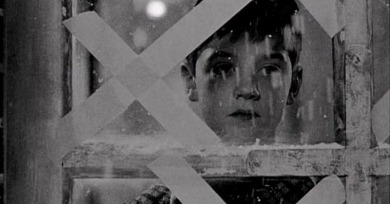Michael Joshua Rowin
The film focuses on the disruption of linear space and time created by psychic phenomena, allowing Roeg to masterfully explore the possibilities of creating, through camerawork and editing, a thoroughly nonlinear temporality even while depicting a succession of events.
The Big Sick was directed by Michael Showalter, whose anarchic sensibility (as best represented in his absurdist sketch comedy troupes The State and Stella) is completely absent from the film.
As the cinematic past increasingly recedes we will probably see a lot more films like Dawson City: Frozen Time, a documentary that attempts to reacquaint viewers with film as film at the same time as it eulogizes the former material basis of the medium.
Jacquot de Nantes depicts the young Jacques Demy as both furiously precocious and fundamentally innocent, devouring the magic, myths, and mechanics of cinema.
A “free adaptation” of Petronius’s fragmented-by-the-ravages-of-time, first-century mock epic, Federico Fellini’s Satyricon (1969) is filled with constant, unexpected laughter.
In the wake of Ryan, realism ceased to be an aesthetic choice or strategy among countless others that might be employed to cinematically portray war; it became a de facto principle, an attitude taken for granted as the obviously correct one for approaching said material.
Rated the lowest of all Coen films on Rotten Tomatoes, and generally spoken of with embarrassment by fans who see it as the nadir of their career, the 2004 version of The Ladykillers—a loose remake of the 1955 British comedy—makes the best case by which to come to terms with the siblings’ thick, often impenetrable, ironic humor.
In a way Falling from Grace goes even further than I’m Not There in refusing to oversell its director-superstar, a man at the time coming off five straight platinum or multiple-platinum records.
While on its very thin surface Samuel Maoz's feature debut takes Israel’s ill-considered 1982 invasion of Lebanon as its subject, the film is more Rear Window than Platoon, and gives new meaning to the phrase “theater of war.”
The problem for Countdown to Zero is how to address the issue cinematically. The threat of nuclear destruction has been endlessly treated in the movies as both theme and MacGuffin ever since Hitchcock’s pre-Hiroshima production of Notorious.
Given the infrequent cinematic output of Terry Zwigoff, bitter, parodic, button-pushing misanthropy is rarely represented at the local art house. But Solondz has not helped fill the void. If anything, he precipitated it.
Kaufman demonstrates with the execution of this single word—and all that leads up to it—a mastery of dialogue as sound, and sound as delivered through the cinema-specific device of voiceover narration.
Cyrus bears an unmistakably stunted relationship to his mother. He calls her by her first name, spends an inordinate amount of time with her to the exclusion of any other friends, and engages in creepy behavior, including using the bathroom while she showers.
This homecoming, of sorts, is welcome. Jeunet has always proudly embraced making movies with massively wide appeal, but since signature debut Delicatessen and the lesser but fitfully captivating The City of Lost Children, each attempt to reach an ever-larger audience has forced him to undermine his already narrow talents.
Hong Sang-soo’s latest, Night and Day, opens by misdirecting its audience with a credit sequence scored to the allegretto movement of Beethoven’s Symphony No. 7.
Jonathan Parker’s high art send-up (Untitled) practically begs crippling questions about its own existence: for instance, to whom is such a film supposed to appeal?
The film opens on a small marketplace in the Philippines before the turn of the 20th century. It’s shot in a very specific quality of luminescent black-and-white that reminds of certain 1920s and 30s Hollywood cinema—gauzy, diffuse, a little dreamy.
Afterschool plays like a film student’s demo reel of the various ways to signify “alienation”—shallow depth of field, over-lit sterile interiors, ambient sounds of fluorescent light hums, expressionless actors, methodical tracking shots frequently overrunning or catching up to their human subjects.
Sports fandom is rarely depicted in the movies, but whenever it is it’s usually portrayed as the domain of obsessive, stunted, sociopathic creeps.
In his new film Yasukuni Chinese director Li Ying locates the physical and spiritual embodiment of Japan’s relationship to its own history at the Yasukuni War Shrine in Tokyo, where the souls of the 2.46 million soldiers who died fighting for their country are said to dwell.


















